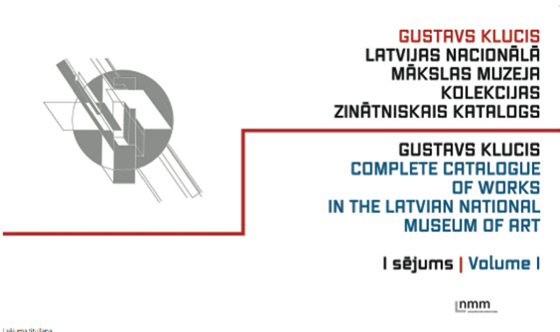|
|
| Gustavs Klucis. Complete catalogue of works in the Latvian National Museum of Art Iveta Derkusova, Art historian In two volumes: 420 and 324 pgs.; edited by Iveta Derkusova; designer Zane Ernštreite; published by the LNMA in collaboration with Neputns Publishing House, 2014. | |
 | |
| The Latvian National Museum of Art is releasing a long-awaited publication, a scientific catalogue with a complete collection of Gustavs Klucis’ (also known as Gustav Klutsis) works in latvian and english. the richly illustrated two-volume publication is not only the catalogue for a collection; it is also a unique summary of primary sources that open up new opportunities for researchers of klucis’ creative work throughout the world. Information on 547 artworks is provided in the scientific catalogue, which has an introduction with a broad summary of the collection’s history; it also brings together for the first time 15 texts written by klucis and his contemporaries. the only known text by klucis himself, that is written in latvian, was also the last publication by the artist. its creation was connected with the only trip to a foreign country during the artist’s lifetime. klucis visited Paris from may 19 until june 24, 1937. during that time he took part in the setting up of the exposition at the ussr’s Pavilion at the international exposition of art and technology in modern life, where he created – as it turned out later – his last significant photo montage. klucis’ essay “impressions of Paris (international exhibition in Paris)”, which was published in the moscow magazine Celtne (no. 10., 1937, pp. 777–782), was in no way connected to his official tasks on the business trip. in a free-flowing style, klucis provided his latvian readers with a review of what he’d seen and done in Paris. the artist’s subjective view, in his evaluation of the pavilions of the various other countries, is interlaced with the required ideological concessions and, in describing the baltic states’ Pavilion, he even becomes ironic. however, it is entirely possible that his criticism is also rooted in professional arguments. REFERENCE: The Latvian Cultural and educational association “Prometejs” published the “Celtne” monthly magazine on literature, art and critique in moscow from 1929 until 1937. Its editor was the journalist and literary critic Pauls Vīksne (1894–1938), and the magazine’s circulation reached 2,500. “Celtne” magazine was closed down after the appearance of its 10th issue in 1937, along with the abolition of “Prometejs” and other Latvian cultural institutions in Russia. | |
| go back | |







